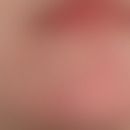DefinitionThis section has been translated automatically.
COL7A1 (collagen type VII alpha 1 chain) is a protein-coding gene located on the short arm of the third chromosome in humans (3p21.31). Despite its 118 exons, it is a relatively densely packed gene; only a single intron measures more than 1 kb in length. It is 31,132 base pairs in size.
General informationThis section has been translated automatically.
The COL7A1 gene encodes the alpha chain of type VII collagen. The type VII collagen fibril, which consists of three identical alpha collagen chains, is restricted to the basal zone beneath stratified squamous epithelia. It functions as an anchoring fibril between the outer epithelia and the underlying stroma.
Mutations in this gene are associated with all forms of dystrophic epidermolysis bullosa. They result in a nonfunctional collagen VII protein, which is a major component of the anchoring fibrils that act like "Velcro" to glue the epidermis to the underlying dermis. A lack of functional collagen VII makes the skin fragile, resulting in severe blistering and erosion of the skin all over the body, followed by scarring and fibrosis.
You might also be interested in
ClinicThis section has been translated automatically.
Collagen type VII, alpha 1 is a protein encoded by the gene COL7A1. Collagen is an important structural protein in humans and is composed of three α1-chains. These α1-chains correspond to collagen type VII, alpha 1. Type VII collagen is found in the skin, where it forms short anchoring fibrils to connect the epidermis to the dermis. In addition, it is found under the multilayered, unkeratinized epithelium of mucous membranes, cornea, and conjunctiva. Mutations in the COL7A1 gene are associated with the numerous variants of epidermolysis bullosa dystrophica - a group of diseases in which the uppermost layer of skin peels off to form blisters.
Diseases associated with COL7A1 include:
Epidermolysis bullosa dystrophica (autosomal dominant) (DDEB).
- Epidermolysis bullosa dystrophica dominant, generalized (OMIM:131750)
- Epidermolysis bullosa dystrophica albopapuloidea (historical Pasini type) (OMIM: 131750)
- Epidermolysis bullosa dystrophica dominant, acral (OMIM:131750)
- Epidermolysis bullosa dystrophica, dominant, pretibial (OMIM:131850) see below.
- Epidermolysis bullosa dystrophica, dominant, pruriginous (OMIM:604129) (see below recessive phenotype)
- Epidermolysis bullosa dystrophica "nails only" (isolated toe-nail dystrophy) (OMIM:607523)
- Epidermolysis bullosa dystrophica dominant, with congenital absence of skin and nail dystrophy (historically: Bart syndrome) (OMIM: 132000)
- Bullous dermolysis of the newborn, dominant (OMIM: 131705)
Epidermolysis bullosa dystrophica (autosomal recessive) (RDEB)
- Epidermolysis bullosa dystrophica recessive, generalized, severe (historical:Hallopeau-Siemens type; (OMIM 226600)
- Epidermolysis bullosa dystrophica, recessive , generalized, intermediate, (historical: non-Hallopeau-Siemens) OMIM: 226650
- Epidermolysis bullosa dystrophica inversa, recessive (OMIM 226600)
- Epidermolysis bullosa dystrophica, recessive, pretibial (OMIM:131850)
- Epidermolysis bullosa dystrophica, recessive, pruriginous (OMIM: 604129)
- Bullous dermolysis of the newborn (OMIM: 131705)
- Epidermolysis bullosa dystrophica, recessive with congenital absence of skin and nail dystrophy (historically: Bart syndrome) (OMIM: 132000) (see below the dominant phenotype)
Note(s)This section has been translated automatically.
Hopes for curing these genodermatoses lie in gene therapy. Recessive dystrophic epidermolysis bullosa (RDEB) is an ideal target for gene therapy because all variants of hereditary RDEB are caused by mutations in COL7A1,. They focus on viral-mediated ex vivo correction of the body's own epithelium. These corrected cells will then be expanded and transplanted onto the patient, following the model of the first successful gene therapy in dermatology in which corrected tissue was transplanted to treat junctional EB (Cutlar L et al. 2014; Wenzel D et al. 2014).
LiteratureThis section has been translated automatically.
- Cutlar L et al. (2014) Gene therapy: pursuing restoration of dermal adhesion in recessive dystrophic epidermolysis bullosa. Exp Dermatol 23:1-6.
- Jacków J et al (2019) CRISPR/Cas9-based targeted genome editing for correction of recessive dystrophic epidermolysis bullosa using iPS cells. Proc Natl Acad Sci U S A 116:26846-26852.
- Lago JC et al (2019) The effect of aging in primary human dermal fibroblasts. PLoS One 14: e0219165.
- Wenzel D et al (2014) Genetically corrected iPSCs as cell therapy for recessive dystrophic epidermolysis bullosa. Sci Transl Med 6:264ra165.




